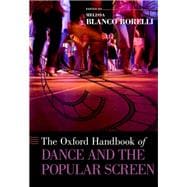The Oxford Handbook of Dance and the Popular Screen

The Oxford Handbook of Dance and the Popular Screen
- ISBN 13:
9780190661540
- ISBN 10:
0190661542
- Edition: Reprint
- Format: Paperback
- Copyright: 04/01/2017
- Publisher: Oxford University Press
.svg) Rent
From $36.96
Rent
From $36.96
List Price $53.33 Save
| TERM | PRICE | DUE |
|---|---|---|



List Price $53.33 Save $0.54
Usually Ships in 3-5 Business Days
We Buy This Book Back!
Free Shipping On Every Order
Note: Supplemental materials are not guaranteed with Rental or Used book purchases.
Extend or Purchase Your Rental at Any Time
Need to keep your rental past your due date? At any time before your due date you can extend or purchase your rental through your account.
Summary
Questions the contributors consider include: How do dance and choreography function within the filmic apparatus? What types of bodies are associated with specific dances and how does this affect how dance(s) is/are perceived in the everyday? How do the dancing bodies on screen negotiate power, access, and agency? How are multiple choreographies of identity (e.g., race, class, gender, sexuality, and nation) set in motion through the narrative, dancing bodies, and/or dance style? What types of corporeal labors (dance training, choreographic skill, rehearsal, the constructed notion of "natural talent") are represented or ignored? What role does a specific film have in the genealogy of Hollywood dance film? How does the Hollywood dance film inform how dance operates in making cultural meanings?
Whether looking at Bill "Bojangles" Robinson's tap steps in Stormy Weather, or Baby's leap into Johnny Castle's arms in Dirty Dancing, or even Neo's backwards bend in The Matrix, the book's arguments offer powerful new scholarship on dance in the popular screen.







